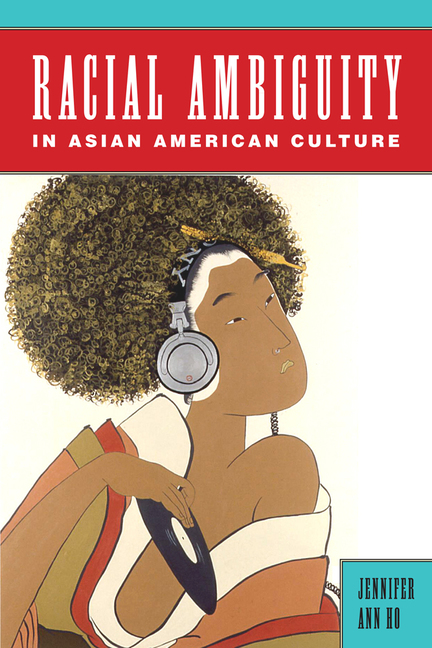How to Rehabilitate a Mulatto: The Iconography of Tiger Woods
Chapter in East Main Street: Asian American Popular Culture (pages 222-245)
New York University Press
May 2005
382 pages
29 illustrations
Cloth ISBN: 9780814719626
Paperback ISBN: 9780814719633
Edited By:
Shilpa Davé, Assistant Dean, College of Arts and Sciences; Assistant Professor of Media Studies and American Studies
University of Virginia
LeiLani Nishime, Assistant Professor of Communication Studies
University of Washington
Tasha Oren, Associate Professor of English
University of Wisconsin, Milwaukee
Foreword by:
Robert G. Lee, Associate Professor of American Studies
Brown University

Chapter Author:
Hiram Perez, Assistant Professor of English
Vassar College, Poughkeepsie, New York
“A Real American Story”
Tiger Woods’s tongue-in-cheek identification as “Cablinasian” on the Oprah Winfrey Show in April 1997 resulted in such contentiousness within the black community that Winfrey followed up later that same month with a program devoted to the “Tiger Woods Race Controversy” Woods’s identification as Cablinasian during that interview has more often than not been taken out of context. He relates arriving at that category (“Ca, Caucasian; bl, black; in, Indian; Asian—Cablinasian”) during his childhood as a survival strategy against racist taunting and violence, including an incident after the first day of kindergarten when he was tied to a tree and called a monkey and a nigger. However, that moment on Oprah when he pronounced the word “Cablinasian” constituted for the multiracial category movement an Amalgamation Proclamation of sorts. Following the program, he was soundly blasted by black media and intellectuals, among them Manning Marable, but such criticism has only deepened the resolve of the multiracial category movement that its ranks are misunderstood and victimized not only by a dominant culture but by other racial minorities, particularly what they regard as a militant, uniracial old guard.
The white parents of biracial (in this case, usually black and white) children constitute the majority of the proponents for the addition of a multiracial category to the census. These parents are attempting to protect their children from what they perceive as the hardships that ensue from identification as black. As Tanya Katerí Hernández explains, “White parents will seize opportunities to extend their privilege of whiteness to non-White persons they care about.” Their naiveté lies in the belief that evading the legal classification “black” or “African American” will entirely spare a child from the socioeconomic and psychic hardships common to black people. An examination of the history of passing confirms that the legacy of hypodescent is never eradicated by the act of passing. Part of the insidiousness of racial classification in the Americas, which relies on notions of racial contamination and purity, is the manner in which that one drop of tainted blood assumes a ghostly life, not just in terms of its symbolic quality (by which the threat of invisibility is managed) but by its perpetual return either across generations or, for the subject who passes, at that inevitable moment of confession or betrayal.
I argue that the celebrity of a figure such as Tiger Woods functions to rehabilitate the mulatto in order to announce the arrival of a new color-blind era in U.S. history. Woods’s multiracial identity is recuperated as a kind of testimonial to racial progress that simultaneously celebrates diversity in the form of Cablinasianness and the multiplicity that category suggests while erasing the histories of black disenfranchisement, racial-sexual violence, and U.S. imperialism that generate, result from, and entrench the legal, scientific, and popular definitions of race, including each racial component of Cablinasianness and their various amalgamations. The word Tiger Woods chooses to describe his racial makeup effects, ironically, his racial unmaking. As I demonstrate in this essay, Nike advertising, with the exception of the company’s very first television advertisement featuring Woods, obliquely references race only to register its insignificance (within the discourse of constitutional color-blindness) or to capitalize (just as obliquely) on racial fantasies about the black body and the Asian body. The Tiger Woods iconography shuttles seamlessly between race consciousness and racial elision. That seamlessness is facilitated by the unlikely union in recent years between the ostensibly incompatible ideologies of multiculturalism and color-blindness. Although multiculturalism and the rhetoric of color-blindness appear to espouse contradictory positions, these philosophies ultimately advance very similar ideologies, as various critical race theorists and cultural critics have already argued. Diversity, as a central goal of multiculturalism, does not transform the economic, legal, and cultural institutions that secure white privilege. Both multiculturalism and color-blindness conceive of racial difference as independent of institutionalized racism. The inconsistencies implicit in the iconography of Tiger Woods (i.e., a celebration of multiraciality that simultaneously heralds color-blindness) become transparent in the U.S.,” provides one of the earliest articulations of the model minority stereotype: “At a time when it is being proposed that hundreds of billions be spent on uplifting Negroes and other minorities, the nation’s 300,000 Chinese Americans are moving ahead on their own with no help from anyone else.” Just as model minority rhetoric functions to discipline the unruly black bodies threatening national stability during the post-civil rights era, the infusion of Asian blood together with his imagined Confucian upbringing corrals and tames Tigers otherwise brute physicality. Some variation of his father trained the body and his mother trained the mind is a recurring motif for sports commentators diagnosing Woods’s success at golf. Earl Woods has encouraged this fantasy:
Her teaching methods weren’t always orthodox, but they were effective. When Tiger was just a toddler, she wrote the addition and multiplication tables out for him on 3-by-5-inch cards, and he would practice them over and over every day. He started with addition and later advanced to multiplication as he got older. His reward was an afternoon on the range with me. Tida established irrevocably that education had a priority over golf. (Woods 9)
The qualities of Woods’s model minority mother compensate for the black man’s cognitive deficiencies. In fact, since the stereotype of the model minority secures the normalcy of whiteness by attributing Asian American successes (the evidence for which is often exaggerated and overly generalized) to a biological predisposition toward overachievement, the contributions of the Asian mother actually exceed the capacity for white blood and a Protestant work ethic to compensate for black degeneracy. Woods’s success at golf, traditionally a sport reserved for the white elite, is in part explained by the logic of eugenics.
The celebration of Tiger Woods as the embodiment of American multiculturalism and racial democracy institutes an instance of “organized forgetting.” Oprah Winfrey’s celebratory vision of Tiger Woods as “America’s son” displaces, for example, historical memories of the bastardized children of white slave owners or U.S. soldiers overseas. Miscegenation as a legacy of slavery is forgotten, as is the miscegenation that has resulted from the various U.S. military occupations in Asia dating back to the late nineteenth century…






